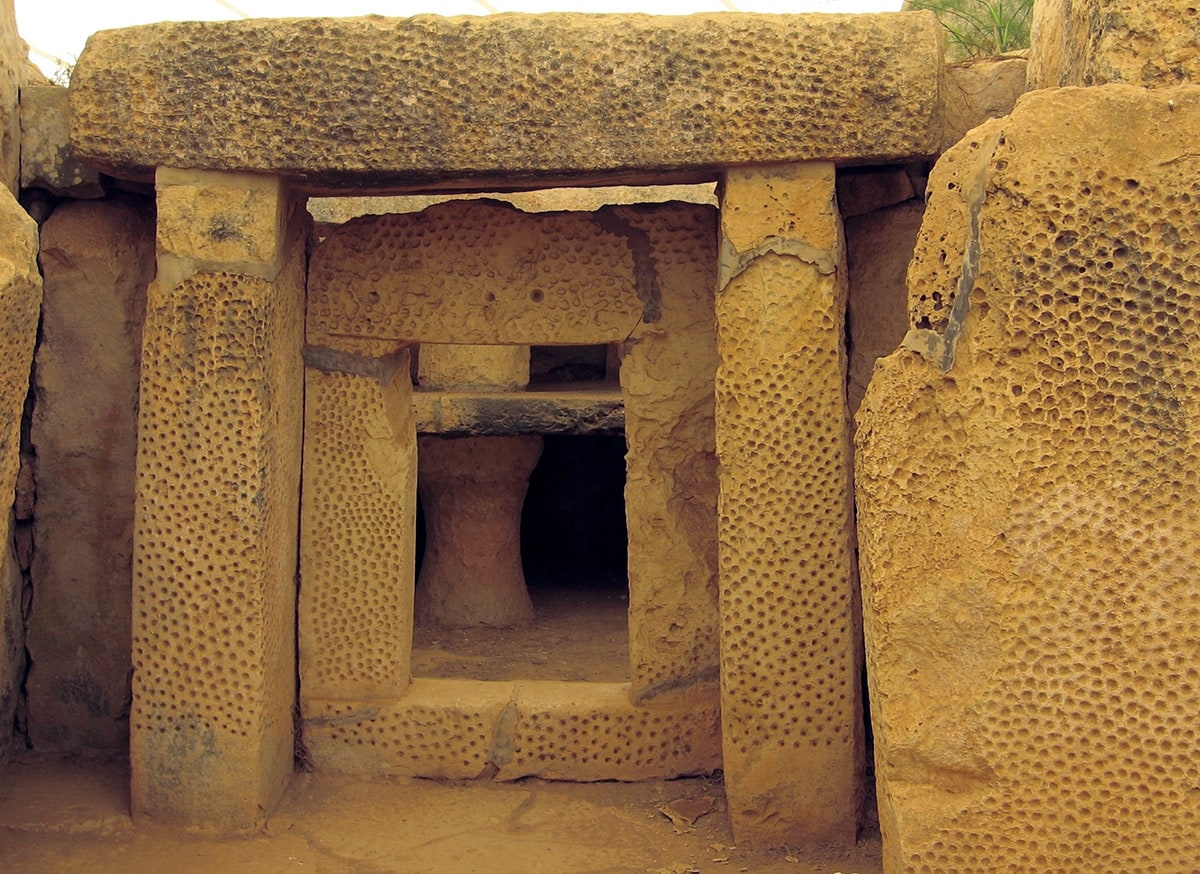Megaliths 🢔 Archaeological wonders 🢔 Categories of wonders
Wonder
Mnajdra
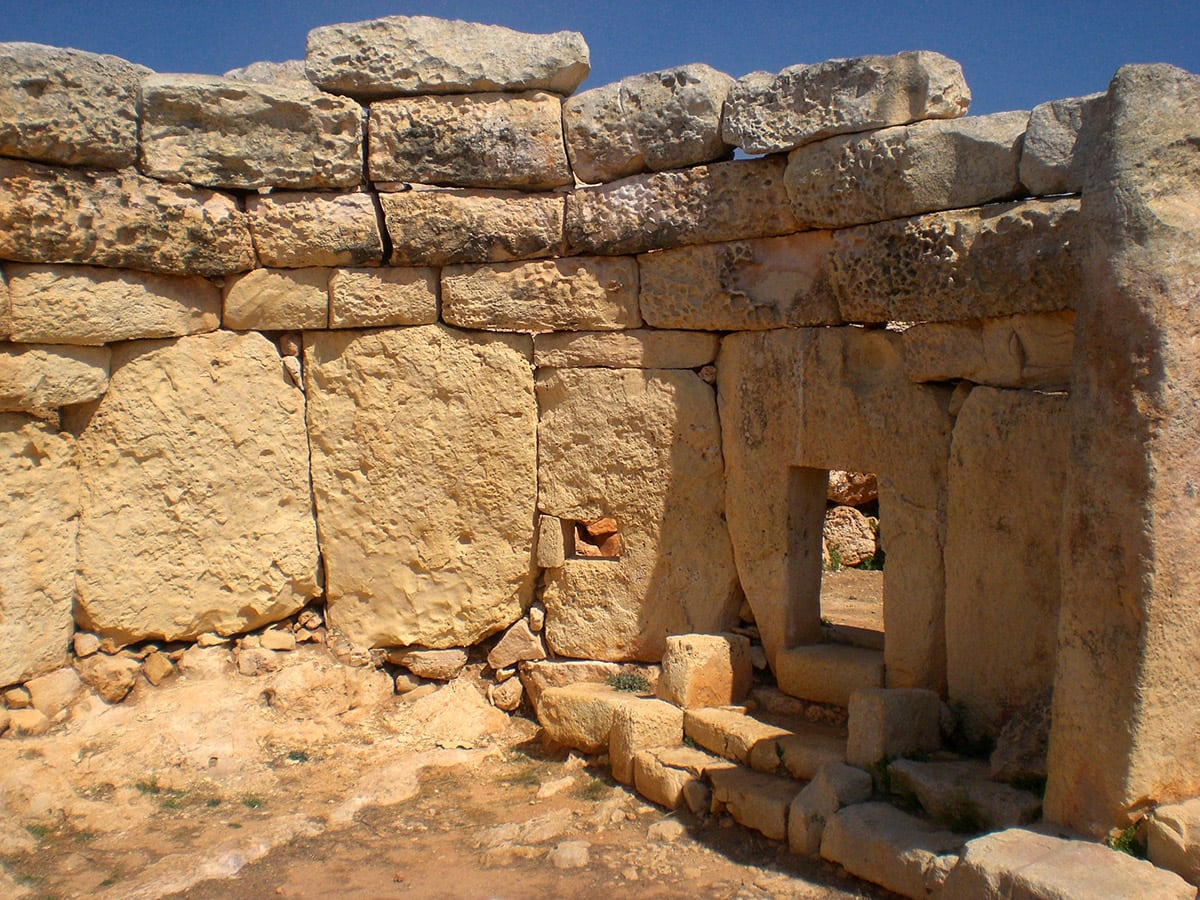
 In short
In short
One of world’s oldest stone structures is Mnajdra – a group of three prehistoric temples which were built with great skill many centuries before Egyptian pyramids and Stonehenge. Prehistoric people had truly great abilities – it seems that these temples have been planned and aligned according to the Sun, serving as a kind of calendar.
 48.0%
48.0%
GPS coordinates
Age
UNESCO World Heritage monument:
Map of the site
If you see this after your page is loaded completely, leafletJS files are missing.
 In detail
In detail
Advanced prehistoric culture
It is not known where they came from – but around 5200 BC there came skilled farmers to Malta. They were not the first people on these islands, but earlier hunters-gatherers could not survive on these small islands after they extirpated the exotic animals of these small islands and disappeared.
Prehistoric farmers of Malta, in turn, were a lot more successful and developed a local culture that for some time was more advanced than other known cultures of the world.
These people created some of the world’s oldest stone structures and we can only wonder: how could they make such sophisticated buildings with their limited resources and prehistoric technologies?
Construction of the unique temples in Malta started around 3600 BC and abruptly ended around 2500 – 2400 BC due to unknown reasons.
Temples at the harbor?
We do not know the original number of prehistoric temples in Malta – some could be lost. But six complexes of these amazing structures have been preserved in a comparatively good shape and since 1992 (Ggantija – since 1980) are included in the UNESCO World Heritage list. One of them, the best preserved is Mnajdra.
Mnajdra temples are located near the rim of a seaside cliff at the southern coast of Malta. Exactly opposite, in the sea, some 5 kilometers from the temple is the small Filfla island but just some 500 m from Mnajdra is another outstanding prehistoric temple complex – Ħaġar Qim.
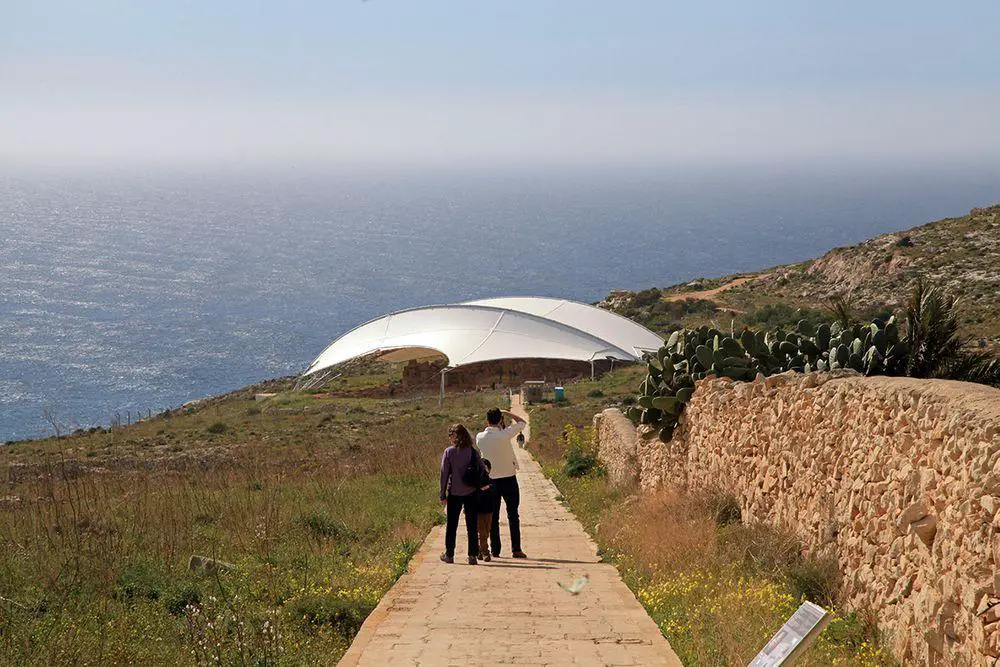
Five – six thousand years ago the level of Mediterranean was somewhat lower than now and here was a suitable place for harbor. Thus prehistoric seafarers had a great arrival to Malta with impressive temple on the cliff towering above the harbor.
Three structures
Mnajdra consists of three closely located but nevertheless separate structures – the upper, middle, and lower temple. Each structure has its own build time and architecture but together they form a typical form of prehistoric Maltese temples – in the plan, they look similar to a cloverleaf.
To the east from the three temples are smaller chambers of unknown function.
There are no written sources about the origin and use of these structures but many finds testify that these were temples. Here have been found stone knives and rope holes for sacrificial animals as well as bones of such animals and other cult-related items. The site contains no traces of human burials.
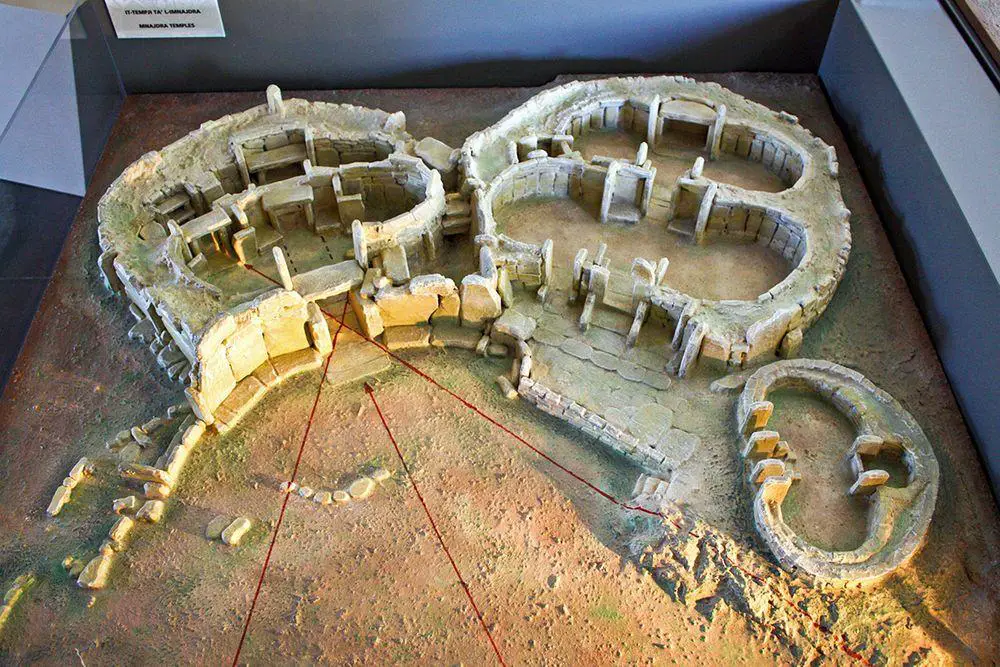
Temples have been made from coralline limestone – a much harder material than in the nearby Ħaġar Qim, which is made mostly from the soft globigerina limestone. In general, the harder coralline limestone was used for the structure of temples while the softer globigerina limestone was for interiors, decorations.
Arches were not invented in these times and roofing was created either by corbels made from smaller stones or posts and lintels from enormous stone slabs.
Time of the construction in Mnajdra is not known with certainty – archaeologists here have relied on structural similarities between the Mnajdra temples and similar temples with known age in other areas of Malta.
Upper temple
This is the oldest temple, built in the Ggantija phase: in the time period between 3600 and 3000 BC. This temple has three apses – three semicircular rooms. One can enter this temple through an interesting megalithic feature – a large stone slab with a door cut in it as if it was a piece of butter. Such entrance doors are typical for prehistoric temples in Malta. Its vaulted ceiling was resting on pillar stones. Small walls have been reconstructed, but the upright stones are original.
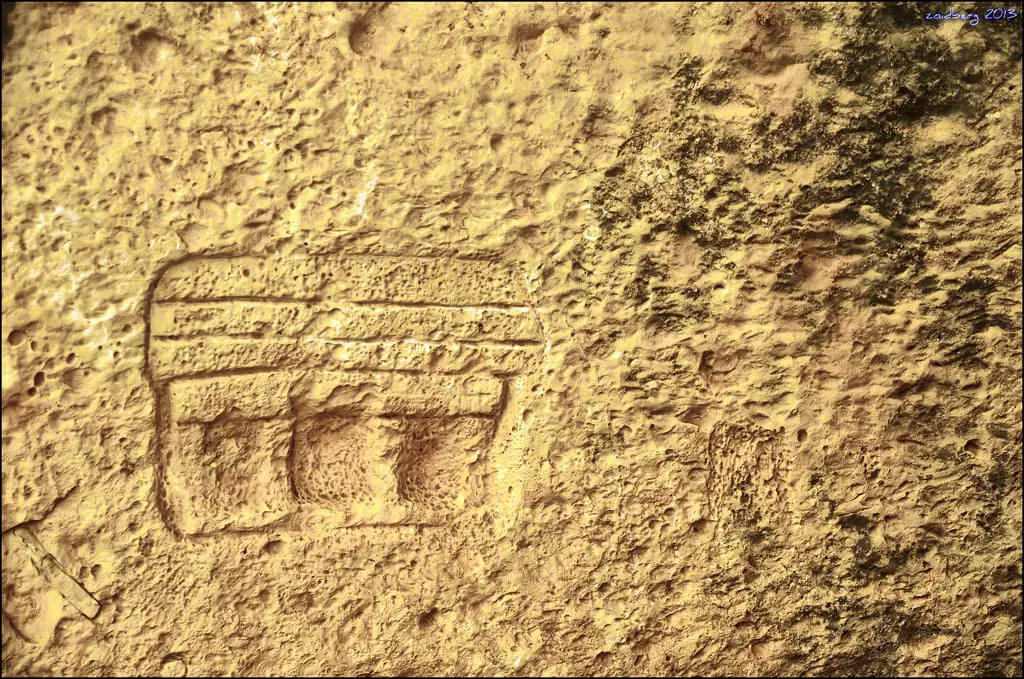
Middle temple
This is the newest temple… if one can say "newest" to a structure which was built in the time period between 3000 and 2500 BC. This temple has been formed from slabs which are covered with large, horizontal stone blocks. Entrance part had (now – broken) an impressive, 3 m tall stone with the door hewn in it. On the left wall of passage is very interesting engraving which shows the temple as it looked from the facade.
Lower temple
This temple was built in the early Tarxien phase, between 3150 and 2500 BC but parts of it could be older, even before 3600 BC. This could be the most impressive megalithic structure in Malta.
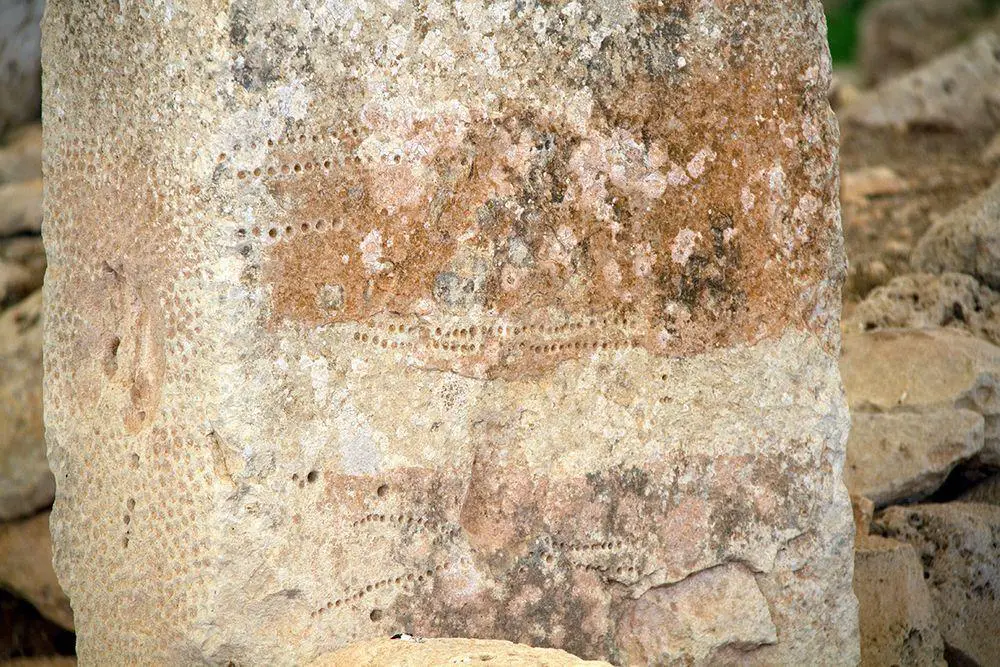
The enormous forecourt has authentic stone benches – just the same where people could be sitting six thousand years ago. The entrance passage was covered with stone slabs – one is still standing. It is possible that the roof of this structure was domed, made from corbelled stones. Inner structures have been largely restored.
This temple has some exciting features. Some stones are decorated with spiral carvings and dots, some monoliths are covered with hundreds of closely located dots.
These dots are linked to another peculiarity: it seems that prehistoric people aligned this temple astronomically: in spring and autumn equinox Sun shines through the main doorway along the major axis of the temple. During the solstices, the Sun shines on the edges of megaliths on both sides of the doorway. And – now regarding the dots: one stone pillar in the temple has numerous small dots in a row – as if somebody has been counting days between equinoxes. There are 179 (with possibly two more) dots in one line – as many as days between equinoxes.
Recent history
Mnajdra is one of the symbols of Malta – it is also depicted on Maltese coins of 1, 2, and 5 cents. Temples have been explored since 1840 and there are numerous scientific articles and even books about Mnajdra and we can be sure that there will be many more in the future.
Weird and sad events took place here on 13th April 2001. Unknown people vandalized the temple during the night: some 60 stones of the Middle Temple and Lower Temple were toppled and damaged with crowbars as well as covered with graffiti – crosses drawn with chalk. It is possible that this crime was committed by an occult sect, possibly under the full moon of Good Friday, the 13th.
Happily modern restoration technologies including the use of reversible hydraulic lime allowed restoring the stones. There arose a discussion that the unique Maltese temples should be closed to the public but nevertheless, in 2002 the temple was reopened to visitors.
In 2007 – 2009 over Mnajdra and over the nearby Ħaġar Qim were built protective tents to protect them from the elements – Sunlight and direct heat, wind, and rain.
Recommended reading
- Tore Lomsdalen, Sky and Purpose in Prehistoric Malta: Sun, Moon and Stars at the Temples of Mnajdra. 2014. ISBN 978-1-907767-41-8
 Linked articles
Linked articles
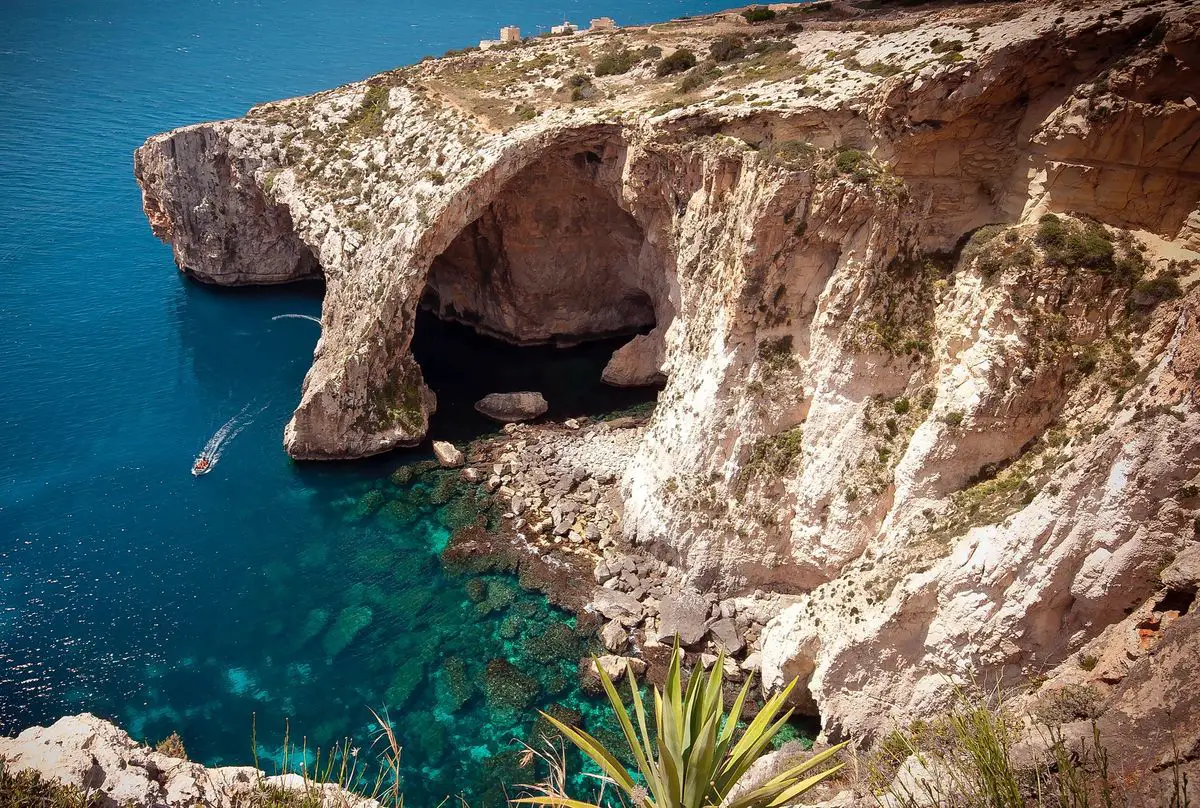
Wonders of Malta
If one looks for a world champion in the density of amazing and unique landmarks, Malta easily could be the one. This tiny island country has some of the world’s oldest temples, some of the most impressive Baroque churches, beautiful medieval towns, and some archaeological mysteries.

Megaliths
One of the most fascinating groups of archaeological monuments are prehistoric structures made of stones – megaliths. Through the ages, people have loved to strain their minds to find a sensible explanation for the many riddles posed by megaliths.
Even today, we can admit with some pleasure, there are thousands of mysteries left for us.

Wonders of Europe
The heritage of Europe is diverse and endlessly interesting. Incomparably rich is the wealth of European historical architecture, but this part of the world has exciting natural heritage and archaeological heritage as well.
 Recommended books
Recommended books

